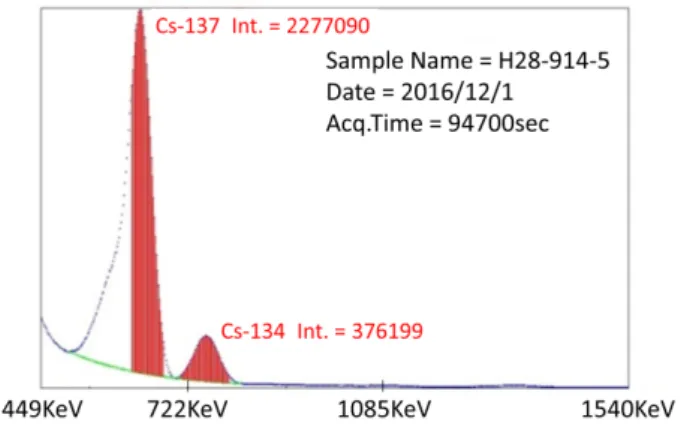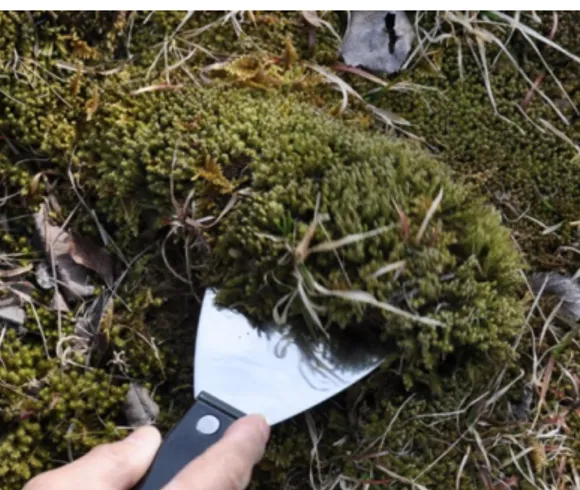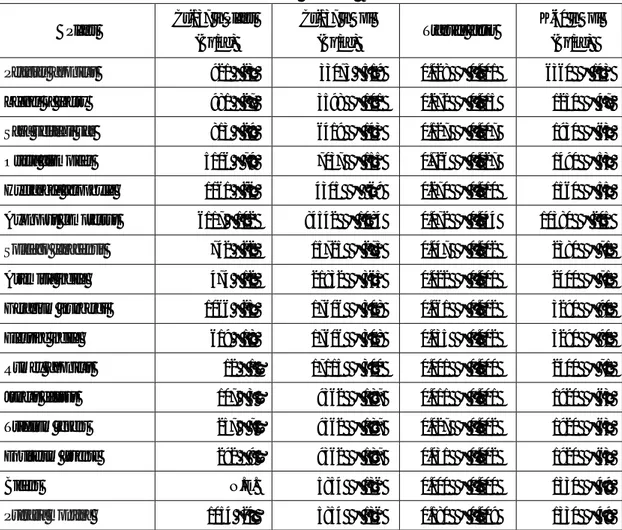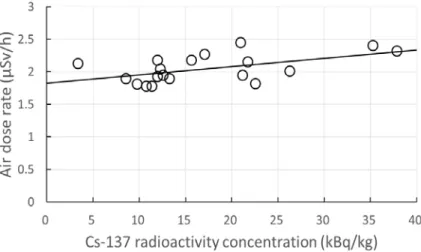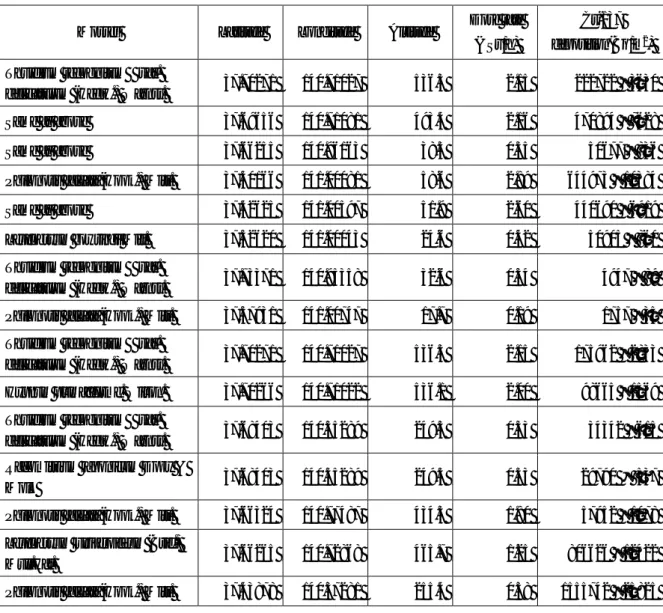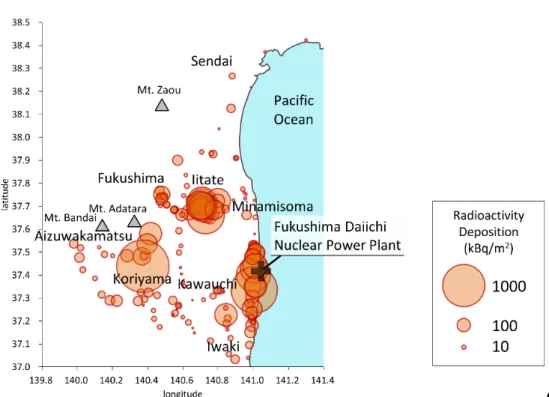Study of Cs-137 Dispersion by the Fukushima Nuclear Power Plant
Accident through Radioactivity Analysis of Mosses
Soji Ohara1, Atsushi Mukai2, Noboru Fujiwara1 1- Nara Gakuen University, Ikoma-gun, Nara, Japan 2- Fukuyama City University, Fukuyama, Hiroshima, Japan
ohara@naragakuen-u.jp
ABSTRACT
The dispersion of Cs-137 by the Fukushima Daiichi Nuclear Power Plant accident (Fukushima accident) was studied through a radioactivity analysis of more than 120 samples of mosses. Moss is a plant that grows abundantly any area of Japan. It was reconfirmed that mosses have an extremely higher ability to retain Cs-137 than other plants. The reason is considered to be that the moss absorbs Cs-137 in rainwater directly into the body not through the rhizoids from the soil. The difference in Cs-137 retention between different types of mosses is small. It is also easy to estimate the fallout value as the Cs-137 deposition in a unit of Bq/m2 because the moss forms two-dimensional colony.
Mosses around eastern Fukushima Prefecture were collected and their radioactivity was analyzed. It was revealed that the radioactivity analysis of mosses is useful for obtaining the map of Cs-137 deposition transported from the nuclear power plant. The Cs-137 deposition map supports the estimation that the plume from the Fukushima Nuclear Power Plant transported to the Koriyama City via the Kawauchi Village in the morning of March 15, 2011, and transported again to the Koriyama City via the Iitate Village and the Fukushima City in the afternoon.
Keywords: Mosses, Cs-137 deposition, Fukushima Daiichi Nuclear Power Plant accident. 1. Introduction
An overwhelming earthquake occurred of magnitude 9.0 at 14:46 on March 11, 2011. It was the largest earthquake in the history of Japan. The epicenter was located on the northern latitude 38 degrees 6.2 minutes, east longitude 142 degrees 51.6 minutes, at a depth of 24 km. It was a plate boundary earthquake that occurred at the boundary of the North American Plate and the Pacific Plate. The plate interface slipped for more than 10 m for a distance greater than 200 km at the location of the epicenter, which is located 100 km offshore from the Pacific coast of East Japan [1]. The sea bed was raised by more than 1 m immediately above the epicenter, causing a gigantic tsunami with a height of more than 10 m. The tsunami with an inundation height greater than approximately 15 m got over the breakwater the height of which was greater than 6.1 m and hit four reactors constructed on the coast at 10 m above sea level.
Reactors 1, 2 and 3 in operation emergency stopped when the earthquake occurred; however, the decay heat could not be cooled down by the cooling water circulation system as it did not
work because the tsunami had inundated the emergency power system established underground designed to avoid the hurricane damage in the U.S. By then the nuclear reactor core temperature had risen. The reaction of zirconium on the high-temperature fuel rod with water released hydrogen gas. The hydrogen explosion occurred in Reactor 1 on March 12th and in Reactor 3 on March 14th.
The primary factor causing the magnificent atmospheric dispersion of radionuclides was the damage sustained by the containment vessel in Reactor 2 on March 15th. Between March 12th and March 22nd, the plume of nuclear fission products was released and diffused at a distance in accordance with the weather conditions, the direction of wind, and the rainfall and the snowfall. In September 2014, the Science Council of Japan estimated that the total amount of released Cs-137to the atmosphere was 14.6 ± 3.2 PBq [2].
The project was launched at Nara-Gakuen University soon after the accident to investigate the initial dose rate and the radioactivity concentration of plants and soils in regions of the Fukushima Prefecture where access was permitted.
We aim at obtaining the actual state of Cs-137 fallout by the Fukushima accident. It is confirmed that the ambient dose rate does not necessarily reflect the Cs-137 deposition amount of the soil just below. It has also been studied that the deposition amount of Cs-137 is highly dependent on the type of plant and soil. The most influential candidate for finding the regional distribution of Cs-137 deposition is moss, which has a high retention of Cs-137 with low dependency on type and can be found in every place in Japan.
In the first stage of the investigation, the subject was the radioactivity concentration depending on the plant and soil type. In the next stage, the dispersion of radioactivity of Cs-137 was studied through the analysis of collected mosses, with a focus on their high retention of radioactivity [3].
Many studies are reported on the dispersion state of radioactivity after the Fukushima accident: the study of the dose rate distribution over a wide area [4], the study of the dispersion of radioactivity by the analysis of soils [5], and the study of the radioactivity transfer in plants [6]. Much valuable information about the transportation of radioactivity according to the geography, water flow, soil, and vegetation were obtained by these studies and the knowledge was applied to the decontamination of radioactive materials of affected areas. However, the decontamination does not seem to be necessarily effective to obtain a safe dose rate environment. By obtaining a more accurate deposition map, a more effective decontamination method can be developed.
Since the Chernobyl accident, several studies have reported on the regional distribution of radioactivity by the analysis of mosses [7]. This paper mainly focuses on the large area dispersion of radioactivity by the Fukushima accident, by taking advantage of the higher retention ability of Cs-137 of mosses than that of soils or other plants.
2. Material and methods
2.1 Measurement of gamma ray
Air radiation dose rates were measured on site with a DC-100 radiation counter produced by Japan Precision Instruments Inc. The gamma ray activities were determined using an INTECH
NaI (Tl) scintillation counter. The scintillator is 2.0 inches in diameter and 2.0 inches in thickness. The collected samples were measured after proper preprocessing in a laboratory.
The energy resolution of the NaI scintillation counter is 7.8% (full width at half maximum) at 662 keV, the gamma ray peak position of Cs-137, so that the Cs-134 peak at 605 keV could not clearly be separated from that of Cs-137. Then the intensity of Cs-137 is obtained by the integration biased toward high energy side. Figure 1 shows an example of the energy spectrum of moss. The background level in the spectrum is rejected by the computer simulation.
A polypropylene (PP) vessel for volatile chemicals with a 6 cm diameter and 9 cm depth was used as the sampling vessel. For the standard sample, IAEA 372 (powder, 100 g, Cs-137; 9628Bq/kg, K-40(1461keV); 1060Bq/kg) was used to determine the radioactivity concentration of plants, soils and mosses. IAEA 372 powder accounts for about 90% of the PP vessel. The unknown samples were set in the vessel with a similar bulk thus avoiding the influence of the difference of an optical system.
Figure 1. Energy spectrum of Cs radioactivity in mosses 2.2 Radioactivity analysis of plants and soils
The Iitate Village in the north area of the Fukushima Prefecture was extensively damaged by the fallout that occurred on March 15, 2011, despite being 40 km away from the Fukushima Daiichi Nuclear Power Plant. This was likely due to the direction of the wind, the unexpected coincidence of rainfall, and the 500 m altitude of the Iitate Village. Since one year after the accident, the natural objects in the Iitate Village were sampled and analyzed to determine the absorption and retention of radioactive materials in them.
The collected plants were weighed after removal of the surface moisture and milled for 30 seconds after being dried by a dryer for 3 hours at 60°C. The weight was decreased by 10%-20% of the original weight before drying. For the estimation of the radioactivity concentration, the weight before drying was used. In the case of moss and soil, only the indoor drying was applied to remove the surface moisture. The coefficient of the sampling into the vessel reproducibility of the gamma ray intensity is ± 1.0% for plants and soils.
For the collected plants, the soils around the roots were also collected and the transfer factors of Cs-137 were obtained from Cs-137 radioactivity concentrations in the soils and bodies of plants.
The natural K-40 radioactivity concentration in the soils around the roots was also obtained to study the influence of antagonistic K for the Cs-137 radioactivity concentration.
2.3 Analysis of radioactivity in farmland soils
Fukushima is an agricultural prefecture. Its total cultivated area is the sixth largest in Japan, so the nuclear power plant accident caused great damage to the agriculture of Fukushima. The local flat land in the Fukushima Prefecture is almost the farmland that is well cultivated and covered with uniform black soil without moss. It will be possible to know the actual state of the Cs-137 fallout, especially, the uniformity of the fallout on a local flat land.
The distribution of Cs-137 radioactivity concentration in a farm in the Iitate Village is studied in this paper. The black soils were collected from the farm, which was flat for more than 1 km and the air dose rate was approximately 2 μSv/h. The soils were collected from a 100 m × 40 m wide area using the sampling tool for soil; each of the 19 samples collected was 10 cm in diameter and 5 cm in depth. Black soil seems to hold Cs-137 radioactivity well so that more than 80% of the Cs-137 assumed to have remained upper 5 cm of surface as reported by this research [3] and other studies [8]. The sampling positions at the farm were obtained by using the GPS.
2.4 Radioactivity analysis of mosses
It is confirmed in our study that moss has a high capability of Cs-137 retention regardless of the type; this rate of retention is, more than 10 times greater than that of other plants. For example, the integrated gamma ray intensities per 100 g during 1000 sec of Hypnum plumaeforme. Wilson. (moss), Axonopus compressus (grass), and surface soil, which were collected from the Villager’s Forest in the Iitate Village within 10 m area, were 120197 counts, 1533 counts and 2245 counts respectively. Several studies [9] conducted after the Chernobyl accident revealed that mosses and lichens experience high retention of Cs-137, which is caused due to the exposure to radiation of the reindeer who eats moss and lichen as a main dietary staple. Mosses absorb water and nutrients directly into their bodies and, not through their rhizoids. This seems to be the main reason why moss has a high retention of Cs-137. The Cs-137 radioactivity concentration of the soil that was 1 cm deep below the rhizoids of the moss was estimated to be 125 Bq/kg. Conversely, the Cs-137 radioactivity concentration of the moss was 3586 Bq/kg. This result means that the moss has retained most of the Cs-137 fallout as compared to the soil under the moss.
Moss and lichen, with adjacent colonies were sampled and analyzed to compare the Cs-137 radioactivity concentration of each. The result was 6448 Bq/kg for moss and 9675 Bq/kg for lichen. The mosses were chosen instead of lichen for this study because they grow naturally everywhere in Japan; it is also easy to estimate the fallout value as the Cs-137 deposition in a unit of Bq/m2 because of the way moss acts as a groundcover. In addition, because of this structure, the mosses were collected in samples by peeling off the colony approximately 15 × 15 cm2 in size. Figure 2 shows the collection scene of a moss (Racomitrium japonicum Dozy & Molk).
Figure 2. Collection scene of a moss (Racomirium japonicum Dozy & Molk).
The colony was dried indoors and cut into a rectangle before measuring the area, and it was loaded into the PP vessel after mixing the cut pieces of colony, approximately 1.5 cm square size each, and then weighed. The coefficient of the sampling reproducibility for the gamma ray intensity is ± 1.5% for mosses. The small amount of soil around the rhizoid was not removed, because the estimation of Cs-137 deposition in Bq/m2 was not influenced by it.
The Fukushima Nuclear Power Plant is located on the Pacific coast 200 km northeast from Tokyo. Radioactivity has spread mainly through the atmosphere to the northwest direction from the nuclear power plant. Several mosses were collected in Hokkaido, Aichi, Wakayama, and Nara Prefecture with the result of no detection of Cs-137 [3]. Then, the influence of the contamination of Cs-137 by the fallout from Hiroshima and Nagasaki atomic bombs, nuclear weapons tests and Chernobyl accident could be considered to be negligible in present analysis.
The main purpose of this paper is to determine how the plume transported to the eastern area of the Fukushima Prefecture and southern area of the Miyagi Prefecture through the analysis of Cs-137 radioactivity concentration of more than 120 samples of mosses collected in permitted areas along the road where we have traveled a total distance of about 2000 km. However, the mosses on the coast area covered by the sea water of the tsunami on March 15, 2011, were not collected.
3. Results and Discussion
3.1 Radioactivity concentration in plants
The results of the analysis of Cs-137 radioactivity concentration of plants collected in the Iitate Village with the results of Cs-137 radioactivity and K-40 radioactivity of soils collected around the root of each plant are shown in Table 2. The results were estimated based on the weight of each plant.
In contrast to these results, the Cs-137 concentration of Hypnum plumaeforme Wils was measured at 115413 Bq/kg and that of Polytrichum juniperinum was measured at 99467 Bq/kg; both were collected in the Iitate Village. These results indicate that mosses, regardless of type, have a retention of Cs-137 that is more than10 times that of other plants.
Of the plants in Table 1, the Cs-137 radioactivity concentrations in Ottelia alismoides and Axonopus compressus are very high. The Cs-137 radioactivity concentration of dry pine cones, pine tree bark, and fallen leaves collected in the Villager’s Forest in the Iitate Village were 24786 Bq/kg, 8343 Bq/kg and 1933 Bq/kg respectively (first six plants in Table 1).
Table 1: Cs-137 radioactivity concentration and its transfer factor for Plants collected in the
Iitate Village. Plants Cs-137 in Plants (Bq/kg) Cs-137 in Soil (Bq/kg) Transfer factor K-40 in Soil (Bq/kg) Petasites japonicus 921 ± 23 33073 ± 519 0.028 ± 0.001 6360 ± 143 Leaves of cherry 981 ± 27 3598 ± 101 0.272 ± 0.015 1250 ± 47
Sasa veitchii var 813 ± 29 6419 ± 143 0.127 ± 0.007 1930 ± 63
Ottelia alismoides 5106 ± 79 7037 ± 155 0.726 ± 0.027 1490 ± 53 Hydrangea acrophylla 1161 ± 26 4305 ± 69 0.270 ± 0.010 1560 ± 55 Axonopus compressus 6117 ± 102 84542 ± 1084 0.072 ± 0.044 10380 ± 205 Solidago canadensis 742 ± 22 15725 ± 275 0.047 ± 0.002 2380 ± 71 Artemisia indica 474 ± 12 21832 ± 365 0.022 ± 0.001 2400 ± 71 Geranium thunbergii 1066 ± 25 17606 ± 308 0.061 ± 0.002 3290 ± 90 Eleusine indica 619 ± 18 17606 ± 308 0.035 ± 0.002 3290 ± 90 Rumex japonicus 12 ± 1 17115 ± 300 0.001 ± 0.000 2400 ± 71 Juncus effusus 107 ± 3 9362 ± 187 0.011 ± 0.001 1920 ± 63 Trifolium repens 257 ± 7 9362 ± 187 0.027 ± 0.002 1920 ± 63 Equisetum arvense 292 ± 9 9362 ± 187 0.031 ± 0.002 1920 ± 63 Bidens N.D. 5854 ± 136 0.000 ± 0.000 1330 ± 49 Pueraria montana 1054 ±24 5854 ± 136 0.180 ± 0.009 1330 ± 49
The transfer factor, (Cs-137 concentration of plant) / (Cs-137 concentration of soil around the root), is also estimated as shown in Table 1. The plants are both perennial. Ottelia alismoides demonstrates a comparatively high transfer factor. The difference of between the retention of Cs-137 and the transfer factor may be caused by the difference of the organic component, which could hold the Cs-137 with a strong negative charge [9][10].
It is confirmed that the Cs-137 deposition rate in plants greatly varies depending on the type of plant. Since it is difficult to find the same type of plant in large areas, plants are inappropriate choice for obtaining the information about the broad distribution of Cs-137.
There is no correlation between the K-40 radioactivity concentration in the soil around roots and the Cs-137 transfer factor, though it was confirmed that the Cs-137 transfer factor to rice was decreased by the administration of a stable K to a paddy field [10].
3.2 Radioactivity concentration of soils
The estimated Cs-137 concentrations of soils collected around the Villager’s Forest in the Iitate Village in 2013, which is in the direction of the transporting plume from the Fukushima Daiichi Nuclear Power Plant, are shown in Table 2. The soils Slope (2 m) and Slope (1 m) are surface soil collected on the slope in the Villager’s Forest. These samples were collected from the slope at 2 m and 1 m height respectively from the flat place.This result makes it possible to predict that Cs-137 is moving due to the flow of rainwater. This was confirmed for several soils on another slope in our previous study[3].
The 1 cm deep surface soil with short weeds is the soil collected from the flat place in the Villager’s Forest, including a little trace of short weed and Hypnum plumaeforme Wils. The Cs-137 concentration in soil samples collected from 10 cm deep below the surface is about 1/100 of the surface soil. On the other hand, the 1 cm surface soil without weeds is the soil collected from the place of the camp fire. The effect of vegetation on the retention of Cs-137 is recognized. Even without vegetation, the brown soil on the camp fire could hold Cs-137 in the surface soil several cm deep. The whitish sandy soil collected 20 m away from the location of the camp fire has a low retention of Cs-137. The soil with a dark color, clay-like properties, and organic components seems to have a high retention of Cs-137. From the place with the sandy soil, many radioactive materials are assumed to be transported with the flow of rainfall.
The above results indicate that the negative charge of plant-derived humic substances [11], have an overwhelming retention of Cs-137. It is said that 50% of the farmland in the Fukushima Prefecture includes clay soil. It is believed that the frayed edge site of clay could effectively incorporate Cs+ ion, so the sandy soil without clay has a low retention of Cs-137 as shown in Table 2.
Sediment sample was collected from the bottom of the 50 cm wide stream in the Villager’s Forest. The Cs-137 radioactivity concentration was as low as 260 Bq/kg. The gamma rays from the Cs-137 in the water of this stream were not detected by the measurement for 120000 seconds. The high level Cs-137 estimated in the soil of edge of the pond and water outlet of the pond, where the stream pours, means that Cs+ ions transported adhered to the floating soil, and not with the water as the ion dissolved in water.
There is a large difference in the deposition of Cs-137 depending on the type of soil, and the rate of migration of Cs-137 due to floating soil is also considered to be large. Thus, soil seems to be an inappropriate medium for obtaining information about the distribution of Cs-137 in a large area.
Soils Cs-137 in soil (Bq/kg)
Slope(2 m) 33073 ± 519
Slope(1 m) 44220 ± 668
1 cm deep surface soil with short weed 84542 ± 1184
10 cm deep below above 1636 ± 44
10 cm deep further below above 382 ± 15
1 cm surface soil without weed 3091 ± 88
1 cm deep below above 557 ± 30
2 cm deep below above 36 ± 6
10 cm surface sandy soil 1271 ± 49
10 cm deep below above 377 ± 21
Bottom soil of the stream 260 ± 16
Soil of edge of the pond 29801 ± 483
Soil of water outlet of the pond 19784 ± 342
Farm soil at the Sasu 4306 ± 112
Farm soil at the Magarida 24691 ± 415
3.3 The Cs-137 radioactivity distribution on a farmland in the Iitate Village
The local fallout from the plume, which is a combination of vaporized radioactivity and water vapor, was studied through the analysis of 19 black soils samples collected from a farmland. The air dose rate of 19 locations on the farmland and Cs-137 radioactivity concentrations of soils collected from the corresponding 19 locations are shown on the longitude/latitude map in Figure3. In Figure 3, the size of the circle corresponds with the magnitude of the dose rate and the Cs-137 radioactivity concentration. Figure 4 shows the correlation between the air dose rate and the corresponding Cs-137 radioactivity of the soil. The farmland from which the samples were collected was flat so that the transportation of Cs-137 by the stream of rainfall seemed to be small. As shown in Figure 3, the air dose rate is strongly affected by the Cs-137 radioactivity concentration of the surrounding soil as well as the soil just below. However, it indicates that the dose rate map could estimate the location of the radioactive concentration on the ground with an accuracy of about 10 m in the case of a flat area.
As shown in Figures 3, the fallout of Cs-137 was not homogeneous on the flat farmland in a 100 m × 40 m area. The plume seems to have a three-3 dimensional structure despite traveling 40 km, though rainfall may not always be uniform. If the density of the plume had a sharp distribution in the vertical direction and fluctuated with the wind, then the fallout of Cs-137 was assumed to be localized. Extremes of either acidity (pH<4) or alkalinity (pH>8) can enhance solubility of
radioactive elements. The acidity of the soils was also measured at the same time, with pH values between 6.4 and 6.8; then, there was no correlation with the Cs-137 concentration.
Figure 3. Distribution of radioactivity in the field; (a) air dose rate (μSv/h), (b) Cs-137 radioactivity concentration (kBq/kg).
Figure 4. The correlation between air dose rate and Cs-137 radioactivity concentration of soils
at the corresponding point. (R2=0.291)
3.4 The study of Cs-137 deposition map by the analysis of mosses
The Cs-137 deposition of several mosses of more than 120 samples of mosses collected in the permitted areas within 100 km from the Fukushima Daiichi Nuclear Power Plant from March 2015 to September 2017, are shown in Table 3. The Cs-137 deposition values were converted to the value as of June 22, 2015 with a half-life (30.08 years) correction.
The estimated Cs-137 deposition of two side-by-side mosses of different type, Thuidium recognitum var. delicatulum (Hedw.) Warnst. and Racomitrium japonicum Dozy & Molk, collected from the Kawamata Town in the Fukushima Prefecture are 34342 Bq/m2 and 29790
Bq/m2, respectively. The difference is within ±10% of the average despite the difference in morphology between the two mosses.
Figure 5 shows the Cs-137 deposition map with the latitude and longitude values obtained using GPS. The size of red circle corresponds to the magnitude of the Cs-137 deposition. The area between the Fukushima Daiichi Nuclear Power Plant and the Iitate Village is currently a no-entry area. General features of two-dimensional dispersion of Cs-137 radioactivity are in agreement with the dose rate map reported by the Ministry of Education of Japan (2014). However, another hotspot was discovered in Koriyama City, the data for which is described on the last row of Table 3.
How did the plume transport from the nuclear power plant to Koriyama City via the Iitate Village and the Kawauchi Village on the afternoon of March 15, 2011? The plume was assumed to be transported as followsfrom the result shown in Figure 5;
1) During the early morning of March 15th, a large release of radioactivity occurred at Reactor 2 of Fukushima Daiichi Nuclear Power Plant and the plume was generated. The plume consisted of vaporized Cs-137 and water vapor.
2) At first wind from the north direction carried the plume to the Iwaki City.
3) Wind from the northeast direction carried the plume via the Kawauchi Village to Koriyama City (around 14:00) with fallout of Cs-137. The arrival time is estimated from data collected from the monitoring post at each location.
4) Wind from a south direction may have blown sometimes at around noon in March 15 and carried the plume to the south area of the Miyagi Prefecture.
5) Wind from a southeast direction occurred at around 14:00 and carried the plume to the Iitate Village (around 16:00). The rainfall began soon after the arrival of the plume at the Iitate Village.
6) The plume beyond the Iitate Village changed its course to the south-south west direction by the wind from the north-north east alpines Zaou (1842 m), Adatara (1819 m) and Bandai (1718 m). The plume transported to Koriyama City over a short period of time. The hotspot in Koriyama City was created by radioactivity from two different plumes via the Kawauchi Village and the Iitate Village.
The rainfall taking the plume is an important factor in the fallout of Cs-137 or “washout”; however, the plume may deposit moisture onto moss if it comes in contact with the moss. The Cs-137 deposition in mosses seems to be uniform beyond imagination except for some hotspots, despite attenuation due to washout by rainfall. Fallout mechanisms other than washout by the rainfall should also be considered, including the bonding between the plume and moisture on the moss.
Table 3: Several results of Cs-137 radioactive concentration in mosses collected in the
Mosses Latitude Longitude Altitude Dose rate (μSv/h)
Cs-137 deposition(Bq/m2) Thuidium recognitum var.
delicatulum (Hedw.) Warnst. 37.70271 140.71027 536.3 2.15 222722 ± 3630
Same as above 37.69656 140.71081 493.4 2.16 470894 ± 7628
Same as above 37.66255 140.96163 38.3 0.35 50677 ± 836
Philonotis falcata(Hook.) Mitt. 37.40166 141.00081 58.6 2.89 644973 ± 10384
Same as above 37.42625 141.00597 51.9 2.60 440690 ± 6919
Leucobryum bowringii Mitt. 37.52620 141.00043 24.6 0.42 50905 ± 860
Thuidium recognitum var.
delicatulum (Hedw.) Warnst. 37.73371 140.95358 32.6 0.34 4947 ± 89
Philonotis falcata(Hook.) Mitt. 37.57931 141.00747 17.7 0.19 1757 ± 35 Thuidium recognitum var.
delicatulum (Hedw.) Warnst. 37.70271 140.71027 536.3 2.15 175962 ± 2833 Hypnum plumaeforme. Wilson. 37.70266 140.71022 536.1 2.00 98665 ± 1569 Thuidium recognitum var.
delicatulum (Hedw.) Warnst. 37.68403 140.55289 249.5 0.33 34342 ± 615 Racomitrium japonicum Dozy &
Molk 37.68403 140.55289 249.5 0.33 29790 ± 537
Philonotis falcata(Hook.) Mitt. 37.66324 140.77487 434.3 1.80 57952 ± 1078 Leucobryum juniperoideum (Brid.)
Mull.Hal. 37.66265 140.72868 465.7 1.25 806626 ± 12422
Philonotis falcata(Hook.) Mitt. 37.43878 140.37281 255.4 0.38 1555742 ± 25825
To study the influence of the terrain, particularly a mountain of about 200 m, on the transportation of the plume, several mosses were collected from Mt. Hayama in the Iitate Village and analyzed for Cs-137 deposition. Mt. Hayama is 657 m above sea level and the altitude of the Iitate Village is about 500 m, so the relative height of Mt. Hayama is about 160 m. The result is shown in Figure 6. The size of the red circle corresponds to the magnitude of the Cs-137 deposition. Mt. Hayama did not seem to have much of an impact on the transportation of the plume. The arrow in the Figure 5 shows the direction of the transportation of the plume directly from the nuclear power plant.
Figure 5 and Figure 6 show that plume has not been influenced remarkable by the attenuation through rainfall and the mountain of about 200 m as a protective wall. The plume seemed to transport very quickly to a large area without effective loss of the radioactivity.
Figure 5. The dispersion of Cs-137 in East Fukushima and the south Miyagi area obtained by
the analysis of mosses (red circles).
Figure 6. The map of Cs-137 deposition obtained by the analysis of mosses collected around
the Mt. Hayama in the Iitate Village.
The ratio of Cs-134/Cs-137 varies on the degree of burn-up of the reactor fuel[12], then the significant difference of the intensity ratio of gamma rays from Cs-134 and Cs-137 should mean the difference of the reactor which released the radioactivity.
The integrated intensity ratio, Cs-134(796keV)/Cs-137(662keV), has a significantly higher value than 0.33 for three of the mosses collected at three points located approximately 40 km to the south-west of the nuclear power plant. In all other moss samples, this ratio is less than 0.30. Their longitude, latitude, altitude, and the value of the ratio are as follows.
1) 37.276, 140.580, 495.2: 0.34 ± 0.02 2) 37.223, 140.554, 506.0: 0.34 ± 0.01 3) 37.170, 140.656, 572.8: 0.41 ± 0.02
The above three locations are within an approximate radius of 5 km. It is assumed that another plume from Reactor 1 or Reactor 3 rather than Reactor 2, transported to this area with an arrival altitude of around 500 m.
4. Conclusions
Mosses are useful in determining the Cs-137 fallout per unit area because of the feature of high retention of Cs-137 which has low dependency on the type and their colonization structure.
Through the analysis of Cs-137 radioactivity concentration in more than 120 samples of mosses collected in the east area of the Fukushima Prefecture, substantial information was obtained about the transportation of the plume from Reactor 2 and the fallout on March 15, 2011.
The Cs-137 deposition map obtained from the analysis of mosses supports the estimation about the transportation of the plume, i.e., the plume arrived in the Koriyama City via the Kawauchi Village in the morning of March 15 and headed towards the Koriyama City via the Iitate Village and the Fukushima City in the afternoon from the Fukushima Nuclear Power Plant. The gamma ray intensity ratio, Cs-134/Cs-137, has significantly larger values for three mosses collected in three locations, mutual distance is within around 10 km, and altitude is approximately 500 m in the south west direction from the nuclear power plant. The plume may have traveled from a Reactor other than Reactor 2.
5. Acknowledgment
This study was supported by the Nara-Gakuen University as a President Project. It is also supported by Dr. Akira Masaike, one of the directors of “Resurrection of Fukushima.” and Dr. Hiroshi Iwase. The authors also appreciate the cooperation of farmers in the Iidate Village.
6. References
1. Department of International Affairs, Japan Science and Technology Agency (2011), The great east Japan earthquake information from official websites, available at www.jst.go.jp/pr/pdf/great_east_japan_earthquake.pdf, accessed during May 2017.
2. Sectional Committee on Nuclear Accident, Committee on Comprehensive Synthetic Engineering, Science Council of Japan (2014), A review of the model comparison of transportation and deposition of radioactive materials released to the environment as a result of the Tokyo Electric Power Company’s Fukushima Daiichi Nuclear Power Plant accident, available at www.jpgu.org/scj/report/20140902scj_report_e.pdf, accessed during May 2017. 3. Ohara S., A.Mukai, N.Fujiwara (2015), The deposition map obtained through radioactivity analysis
of mosses, Kankyo Gijyutu, 44, pp.460-467 (Japanese version).
4. Sanada Y., T.Sugita, Y.Nishizawa, A.Kondo, T.Torii (2014), The aerial radiation monitoring in Japan after the Fukushima Daiichi nuclear power plant accident, Progress in Nuclear Science and Technology, 4, pp.76-80.
5. Saito K., I.Tanihata, M.Fujiwara, T.Saito, S.Shimoura, T.Otsuka, Y.Onda, M.Hoshi, Y.Ikeuchi, F.Takahashi, N.Kinouchi, J.Saegusa, A.Seki, H.Takemiya, T.Shibata (2015), Detailed deposition density maps constructed by large-scale soil sampling for gamma-ray emitting radioactive nuclides from the Fukushima Daiichi Nuclear Power Plant accident, Journal of Environmental Radioactivity, 139, pp.308-319.
6. Koizumi A., T.Niisoe, K.H.Harada, Y.Fujii, A.Adachi, T.Hitomi, H.Ishikawa (2013), 137Cs trapped by biomass within 20km of the Fukushima Daiichi Nuclear Power Plant, Environmental Science and Technology, 47, pp.9612-9618.
7. Steinnes E., O.Njastad (1993), Use of mosses and lichens for regional mapping of 137Cs fallout from the Chernobyl accident, Journal of Environmental Radioactivity, 21, pp.65-73. 8. Kato H., Y.Onda, M.Teramage (2012), Depth distribution of 137Cs, 134Cs, and 131I in soil profile
after Fukushima Dai-ichi Nuclear Power Plant Accident, Journal of Environmental Radioactivity, 111, pp.59-64.
9. Rigol A., M.Vidal, G.Rauret (2002), An overview of the effect of organic matter on soil-radiocaesium interaction: implications in root uptake, Journal of Environmental Radioactivity, 58, pp.191-216. 10. Ii I., K.Tanoi, Y.Uno, T.Nobori, A.Hirose, N.Kobayashi, N.Nihei, T.Ogawa, Y.Tao, M.Kanno,
J.Nishiwaki, M.Mizoguchi (2015), Radioactive cesium concentration of lowland rice growth in the decontaminated paddy fields in Iitate-Village in Fukushima, RADIOISOTOPES, 64, pp.299-310 (Japanese version).
11. Nakao A., S.Funakawa, T.Kosaki (2009), Hydroxy-Al polymers block the frayed edge sites of illitic minerals in acid soils: Studies in southwestern Japan at various weathering stages, European Journal of Soil Science, 60, pp.127-138.
12. Kawada Y and T.Yamada (2012), Radioactivity ratio of 134Cs/137Cs released by the nuclear accidents, Isotope News, No.697, pp.16-20.
